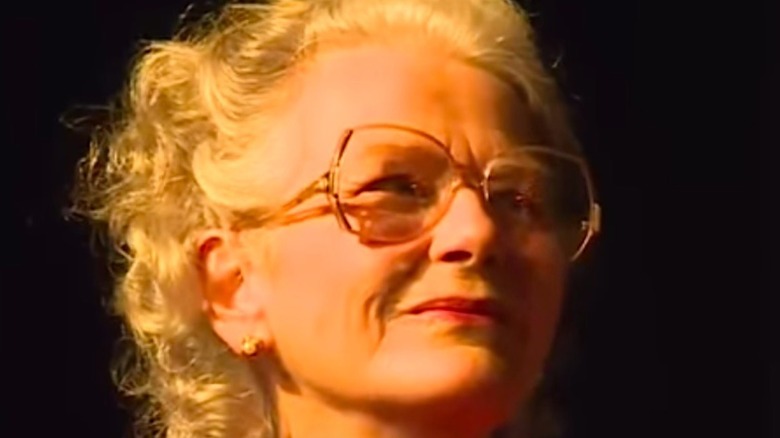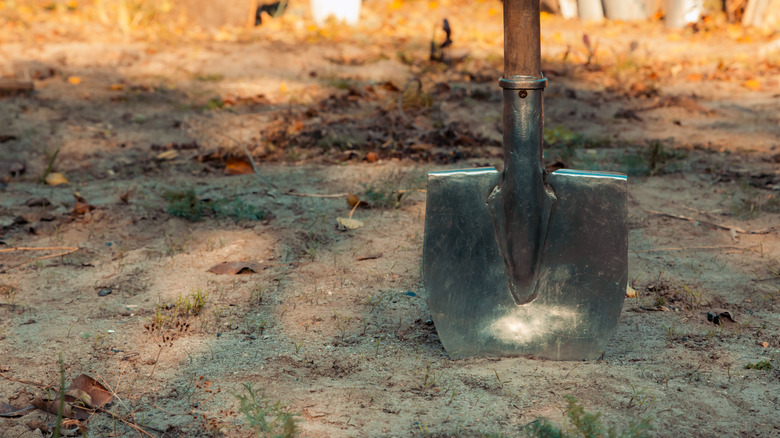What Happened To Dorothea Puente's Victim James Gallop?
Dorothea Puente did not exactly have an easy childhood. The daughter of two alcoholics, she endured a chaotic upbringing before she finally escaped by marrying a soldier named Fred McFaul at the age of 16. However, the marriage lasted only two years before McFaul left her after she suffered a miscarriage at just 19 years old, according to Murderpedia.
Puente would marry three more times in her life, although none of the relationships were happy ones. She also spent time in and out of prison, having been arrested once for using forged checks in her youth and again in 1960 for running a brothel in Sacramento. However, after her third marriage ended in 1968, Puente opened up a 16-bedroom boarding home at 2100 F Street in Sacramento, California. She posed as a sweet and altruistic old lady, renting rooms primarily to those who were down on their luck and needed a place to stay, such as the elderly, addicts, the poor, and the disabled. However, in truth, prosecutors said she was one of the most "cold, calculating" female serial killers California prosecutors had ever seen (via the Los Angeles Times). Many people who checked into her boarding house never checked out.
Puente drugged and murdered her tenants
Throughout the 1970s and 1980s, Dorothea Puente rented out rooms in the downtown Sacramento boarding house, predominantly to elderly people who received government assistance such as disability or Social Security, as well as to drug addicts, the disabled, and others who often found it hard to find lodging elsewhere. Puente's tenants occasionally turned up dead, although initially, this didn't raise too much suspicion since many were elderly and in ill health. But in actuality, Puente was drugging and murdering her tenants, then burying them in the backyard and continuing to cash their Social Security and government checks. All together, Puente collected around $87,000 from her victims at the boarding house, according to the Los Angeles Times.
Tragically, one unfortunate victim named James Gallop fell prey to Puente when he was at his most vulnerable. In 1987, Gallop was diagnosed with a brain tumor and had to undergo a serious operation to have the tumor removed. Following his surgery, Gallop rented a room with Puente where he could recover after being released from the hospital, according to Murderpedia. Sadly, Gallop was never seen alive again.
Police became suspicious after a social worker reported one of Puente's tenants missing
On November 11, 1988, authorities began to look more closely at Dorothea Puente after one of her tenants, a disabled man named Alvaro Montoya, was reported as missing by his social worker (via Murderpedia). The social worker — an outreach counselor with Volunteers of America named Judy — had placed Montoya, who had previously struggled with homelessness, at Puente's boarding house. But she soon became concerned when her attempts to contact him went unanswered.
First, Judy confronted Puente, who assured Judy that Montoya was perfectly fine, telling her that he was simply on vacation in Mexico with his brother. However, this cover story raised some red flags since Judy knew Montoya did not have a relationship with his family. She then spoke to another one of Puente's tenants named John Sharp, who admitted (via The New York Post), "Something is wrong. She's been digging a lot of holes." Now suspicious that there was something very wrong, Judy alerted the police that something shady might be going on at the Puente boarding house.
Police discovered bodies buried in Puente's backyard
When police went to investigate the boarding house, Dorothea Puente told them the same story about Montoya's supposed Mexican vacation. But on their way out, John Sharp gave them another reason to be suspicious, slipping them a secret note that read (via The New York Post), "She's making me lie for her." The police then conducted a full search of the boarding house, and after inspecting the grounds of the house, they noticed that the soil in the back garden had recently been disturbed.
They asked Puente for permission to search the soil in the garden, and she agreed, so they got shovels and set to work digging up the back yard. "We were just digging and digging. And I could see Dorothea staring out the window at us, above," one of the policemen explained (per The New York Post), adding that they had then dug up "pieces of cloth, eggshells, and leather pieces that looked like beef jerky." Except this was no beef jerky — it was really the remains of one of Puente's former tenants, Leona Carpenter.
Puente tried to make a break for it
Buried in Dorothea Puente's back garden, police recovered a total of seven bodies in various states of decomposition, with James Gallop's among them. Ultimately, his body was identified by the metal sutures that had been left in his skull following his brain surgery, according to the Associated Press. When she was confronted by the evidence, however, Puente denied knowing anything about the bodies in her own backyard. "She was emotionless, and she would look straight into my eyes and answer every question. She never flinched. She never said anything. She denied everything," recalled one of the policemen who questioned her (per The New York Post).
Puente did not go into custody quietly. The morning after the bodies were discovered, she left the house, claiming she was meeting her nephew for coffee. Instead, she made a break for it, fleeing to Los Angeles. While in Los Angeles, Puente made the acquaintance of an elderly man in a bar, but by this point, her face was all over the news, according to The Cinemaholic. The man recognized Puente from the broadcast and alerted authorities to her whereabouts, and she was apprehended not long after.
Puente was not convicted of Gallop's murder
Dorothea Puente did not make it to trial until October 1992, in large part because it had to be moved to Monterey County due to excessive media coverage of her arrest, (via the Los Angeles Times). She was charged with a total of nine murders, including the deaths of the seven people found in her backyard as well as the deaths of Everson Gillmouth, a former prison pen pal boyfriend of Puente's whose body was discovered dumped in a riverbank in 1987, and Ruth Monroe, another tenant whose death was initially listed as a suicide (per The New York Post).
After a year-long trial, Puente was convicted of first-degree murder in the deaths of her tenants Dorothy Miller and Benjamin Fink and second-degree murder in the case of Leona Carpenter, The Cinemaholic reports. However, she was never convicted of the other six murders — including the murder of James Gallop — due to a deadlocked jury (per Murderpedia). Puente was ultimately sentenced to two consecutive life sentences without parole. She died in the Central California Women's Facility in Madera County, California, in 2011 at the age of 82. She maintained her innocence until her death, according to the Crime Museum.





